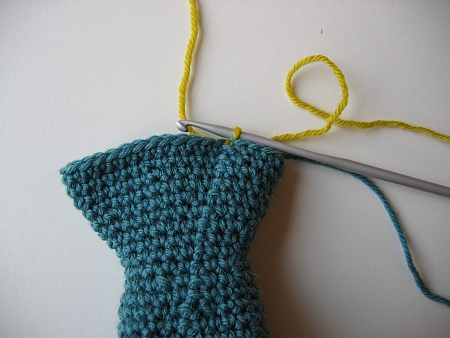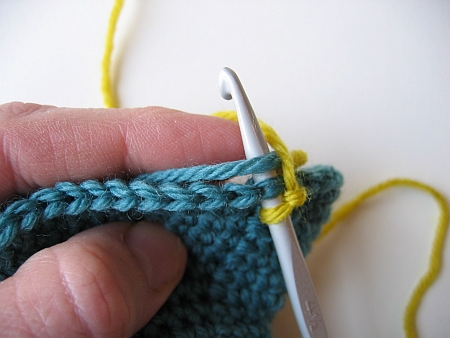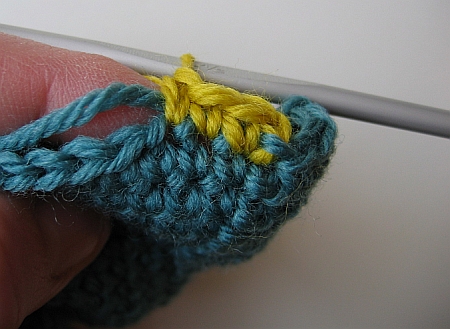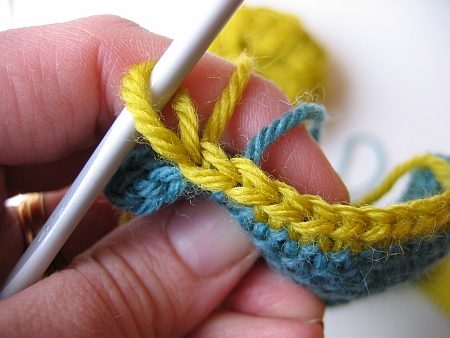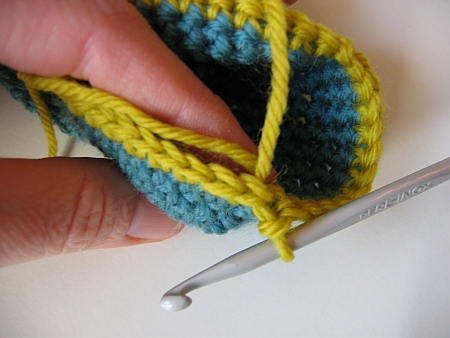News:
In pattern shop news, I am proud to presente Armorique, yet another beautiful shawl designed by the talented EclatDuSoleil.
The pattern is illustrated with detailed step-by-step photos, to ensure an enjoyable experience for any crocheter.
Weaving in ends as you go:
Let’s start off the new year with a nifty little trick that I don’t think I’ve covered extensively before – how to weave in yarn ends as you go.
Some of you may have noticed that I often advocate a zen approach to weaving in ends. Something nice to listen to, something good to drink and a good-quality tapestry needle can make for a pleasant time weaving in ends after the completion of a project.
However, often you don’t really need to do this. You can weave in the ends as you go, without ever needing that tapestry needle. Here is how:
Here I am, working away on a scarf in the round with more or less regular colour changes. I am going to change from teal to yellow, so have closed my round with a slip stitch in the new colour. I have two ends to handle: the teal yarn needs to be secured before it’s cut, to prevent ravelling, and the yellow yarn tail must be woven in.
I’ll start with the teal one, the colour I used on the previous row. It will be much harder to hide if it’s swimming in an ocean of yellow, so we’ll take care of it directly while we still have some teal around.
I place the teal yarn along the top of the work, on the backside (or in this case the inside) of the piece. When putting my hook through each stitch, I make sure I also put it under the teal yarn so that this yarn is caught in the stitch.
The yellow stitches both hide the teal yarn and hold it in place.
After as many stitches as it takes for me to feel safe, I just let go of the teal yarn and continue working with the yellow one. The teal end hangs from the back of my work until I cut it – which I usually do when I’ve completed the row or round and checked the stitch count.
I finish the round and start dealing with the yellow yarn end.
The method is, of course, exactly the same. Bring up the yellow tail from the row below, across the back of the work. Lay it along the top of the work and work around it at the same time as you work into the stitches.
So, why don’t I use this technique all the time?
This technique is not suitable when working thin multicoloured stripes, especially if the number of rows in each stripe is even so that the yarn change happens at the same edge of the project all the time. Even if it’s imperceptible at first, each yarn end that is woven in will make the stitches hiding it very slightly higher. If this happens too often at the same edge, you will end up with a lopsided project.
Another situation where you might want to be cautious is when you’re working an open and lacy stitch pattern. Whenever you skip stitches, the yarn you wish to hide and secure will be exposed for everyone to see – which you may or may not be able to live with.
See you soon!


